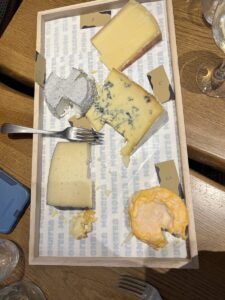I have always been able to relate to the Nick Jonas song that goes “I eat cheese, but only on pizza, please/ And sometimes on a homemade quesadilla/Otherwise, it smells like feet to me”. Not being a big cheese enthusiast, I hadn’t ever really considered visiting a fromagerie, in America nor in France. Surprisingly, this past Wednesday, May 25th, I found myself not only inside Fromagerie Monbleu but also partaking in cheese tasting. When we first arrived at the shop, I was quite surprised by the strong smell that engulfed me. As soon as I stepped foot inside, I knew it would be a new experience, but before I had time to process it all, we were led upstairs and divided into four different groups. As we began, our hostess explained to us the difference between taste and flavor by having us close our eyes and try a spice that she placed in our hands. Initially, we were instructed to eat while blocking the smell. The spice was flavorless, but as soon as we could smell it again, like magic, the flavor was intensely powerful and sharp. Before this experience, I had never considered the role that each sense plays in our perception of food, nor the role that the brain plays in determining what tastes good or bad. I recalled the article regarding the limited cheese intake paradigm for rats and how, for them, cheese is a “highly palatable food that is low in sugar and other carbohydrates” (Fourman et al., 2021). My dislike for cheese coupled with a curiosity about the palatability of food and my experience with taste vs flavor at the fromagerie led me to delve deeper into research on this subject.

I came upon an article about palpability-related taste responses involving the lateral hypothalamus, which piqued my interest. According to Li, Yoshida, Monk, & Katz (2013), there is still much to discover about the lateral hypothalamus and its role in processing taste. In their experiment, they provided mice with four different liquid taste solutions: sweet, salty, sour, and bitter as well as just water to see if any activation occurred in the lateral hypothalamus. They measured the firing of single neurons through electrodes that had been surgically implanted in the rats’ hypothalamus. Li and colleagues found that the lateral hypothalamus indeed does play a role in the palatability of food through two different sections of neurons which are activated by either palatable or adverse tastes.
These findings were very interesting to me and now I wonder where my aversion to cheese taste comes from. In a country where wine and cheese are engraved deeply in the culture, it was very enriching to participate in a cheese tasting, and hope one day I might find a flavor that agrees with my lateral hypothalamus!

References:
Fourman, S., Buesing, D., Girvin, S., Nashawi, H., & Ulrich-Lai, Y. M. (2021). Limited cheese intake reduces HPA axis and behavioral stress responses in male rats. Physiology & Behavior, 242, 113614. https://doi.org/10.1016/j.physbeh.2021.113614
Li, J. X., Yoshida, T., Monk, K. J., & Katz, D. B. (2013). Lateral Hypothalamus Contains Two Types of Palatability-Related Taste Responses with Distinct Dynamics. Journal of Neuroscience, 33(22), 9462–9473. https://doi.org/10.1523/JNEUROSCI.3935-12.2013
